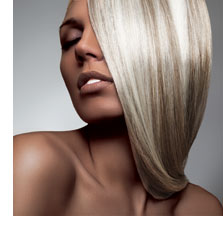New research shows that hair turns gray as a result of a chemical chain reaction that causes hair to bleach itself from the inside out. Alas, scientists have yet to find a way to stop that chemical chain reaction or slow down the appearance of those silvery strands. And until they do, researchers are ramping up efforts to see how the aging process whitens hair.
While pursuing this goal, scientists at the University of Bradford in the United Kingdom found that gray hair is the result of a buildup of hydrogen peroxide in the hair’s cells, which blocks the normal creation of melanin (the dark pigment found in hair and skin). This buildup occurs because aging bodies produce less catalase, an enzyme that breaks down hydrogen peroxide in hair into water and oxygen. The result? Good-bye black and hello gray.
 |
But here’s promising news. Manufacturers are producing supplements that contain catalase. One called Go Away Gray also provides other well-known, go-away-gray ingredients, such as horsetail, foti, PABA and nettle root. The product promises that these ingredients can restore hair’s natural color and prevent gray hairs. Naturopathic physician Valerie Lane Simonsen, ND, finds the product “interesting” but cautions that your lifestyle and overall health determine how your hair responds to anti-graying treatments. So don’t toss your bottle of Dark & Lovely just yet.
“The bottom line for gray-hair prevention is knowing that graying is caused by multiple factors, which are not all under our control,” says New York dermatologist David E. Bank, MD. He points to an enzyme called methionine sulfoxide reductase A and B (MSR A and B). It helps follicles repair damage caused by hydrogen peroxide. But like catalase, this enzyme also declines with age. And without enough MSR A and B, the body struggles to produce enough of another enzyme, tyrosinase, which helps melanin reach the hair shaft.
“Melanin is what gives our hair its color. Hence it’s safe to say that replacing a single component, catalase, which these [kinds of products] claim to do, will not solve the problem of graying hairs caused by age or heredity,” Bank explains. “But in cases where gray hair is caused only by a catalase deficiency, the supplement may work.”
The catalase supplement isn’t the only product on the market advertised as a cure for graying hair. Many people turn to Chinese medicine, a treatment that links hair’s health with clean blood. According to this theory, when the body efficiently eliminates waste, the blood is healthier—and that means fewer gray hairs. People can support the process by helping the body rid itself of waste. “Silica is a natural remedy that cleanses the body by eliminating waste,” Simon-sen explains. “This cell salt purifies the blood and enhances digestion. Better digestion leads to healthy hair, skin and nails.”
But even though an overall healthy lifestyle may help slow down hair’s natural graying process, this doesn’t prevent it. “While there are no treatments to stop hair from naturally going gray, there are ways to improve overall hair and scalp health, which [in turn] can prevent premature graying,” Bank says.
What this means is that until a product can actually stop silvery strands from sprouting, then permanent dyes are the best bet for fully covering gray—especially if you’re sporting 50 percent or more silvered hair. But hair dyes raise health concerns. Some chemical ingredients in these products are believed to be unsafe. Another option? Try safer semi-permanent dyes and touch-up kits that temporarily cover gray. And don’t overlook temporary fixes too. Mascara-type wands and cover sticks can color gray hair in between salon visits. But these tend to rub off. Word is, though, a new hair color marker called TouchBack withstands rubbing and brushing and lasts until shampooed out. Another cover-gray option is to use natural dyes. “A rinse made by boiling coconut oil and henna leaves, for example, can eventually turn gray hair brown,” Bank says.
Still, more women are forgoing neverending touch-ups and learning to accept, love and wear their silver locks—and to do so with style.
Celebrity stylist and SoftSheen-Carson artistic director Johnny Wright observes: “Going gray is a very natural process. Many women are embracing what [God] gave them and enhancing their gray hair, and they look amazing. The key is, start with healthy hair and a great cut.”






Comments
Comments